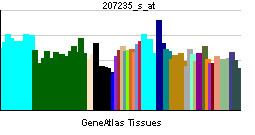Entrez 2915 | Ensembl ENSG00000168959 | |
 | ||
Aliases GRM5, GPRC1E, MGLUR5, PPP1R86, mGlu5, glutamate metabotropic receptor 5 External IDs MGI: 1351342 HomoloGene: 37354 GeneCards: GRM5 | ||
Metabotropic glutamate receptor 5 is a G protein-coupled receptor that in humans is encoded by the GRM5 gene.
Contents
Function
The amino acid L-glutamate is the major excitatory neurotransmitter in the central nervous system and activates both ionotropic and metabotropic glutamate receptors. Glutamatergic neurotransmission is involved in most aspects of normal brain function and can be perturbed in many neuropathologic conditions. The metabotropic glutamate receptors are a family of G protein-coupled receptors, that have been divided into 3 groups on the basis of sequence homology, putative signal transduction mechanisms, and pharmacological properties. Group I includes GRM1 and GRM5 and these receptors have been shown to activate phospholipase C. Group II includes GRM2 and GRM3 while Group III includes GRM4, GRM6, GRM7, and GRM8. Group II and III receptors are linked to the inhibition of the cyclic AMP cascade but differ in their agonist selectivities. Alternative splice variants of GRM8 have been described but their full-length nature has not been determined.
Ligands
In addition to the orthosteric site (the site where the endogenous ligand glutamate binds) at least two distinct allosteric binding sites exist on the mGluR5. A respectable number of potent and selective mGluR5 ligands, which also comprise PET radiotracers, has been developed to date. Selective antagonists and negative allosteric modulators of mGluR5 are a particular area of interest for pharmaceutical research, due to their demonstrated anxiolytic, antidepressant and anti-addictive effects in animal studies and their relatively benign safety profile. mGluR5 receptors are also expressed outside the central nervous system, and mGluR5 antagonists have been shown to be hepatoprotective and may also be useful for the treatment of inflammation and neuropathic pain. The clinical use of these drugs may be limited by side effects such as amnesia and psychotomimetic symptoms, but these could be an advantage for some indications, or conversely mGluR5 positive modulators may have nootropic effects.
Agonists
Antagonists
Positive allosteric modulators
Orthosteric antagonists
Negative allosteric modulators
mGluR5 and addiction
Mice with a knocked out mGluR5 show a lack of cocaine self-administration regardless of dose. This suggested that the receptor may be intimately involved in the rewarding properties of cocaine. However, a later study showed that mGluR5 knockout mice responded the same to cocaine reward as wild type mice demonstrated by a cocaine place-preference paradigm. This evidence taken together shows that mGluR5 may be crucial for drug-related instrumental self-administration learning, but not conditioned associations.
